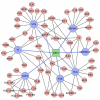Virus host protein interaction network analysis reveals that the HEV ORF3 protein may interrupt the blood coagulation process
- PMID: 23418552
- PMCID: PMC3571956
- DOI: 10.1371/journal.pone.0056320
Virus host protein interaction network analysis reveals that the HEV ORF3 protein may interrupt the blood coagulation process
Abstract
Hepatitis E virus (HEV) is endemic worldwide and a major cause of acute liver disease in developing countries. However, the molecular mechanisms of liver pathology and clinical disease are not well understood for HEV infection. Open reading frame 3 (ORF3) of HEV encodes a small phosphoprotein, which is assumed to be involved in liver pathology and clinical disease. In this study, the interactions between the HEV ORF3 protein and human proteins were investigated using a stringent, high-throughput yeast two-hybrid (Y2H) analysis. Thirty two proteins were shown to interact with genotype 1 ORF3, 28 of which have not been reported previously. These novel interactions were evaluated by coimmunoprecipitation of protein complexes from transfected cells. We found also that the ORF3 proteins of genotype 4 and rabbit HEV interacted with all of the human proteins identified by the genotype 1 ORF3 protein. However, the putative ORF3 protein derived from avian HEV did not interact with the majority of these human proteins. The identified proteins were used to infer an overall interaction map linking the ORF3 protein with components of the host cellular networks. Analysis of this interaction map, based on functional annotation with the Gene Ontology features and KEGG pathways, revealed an enrichment of host proteins involved in complement coagulation, cellular iron ion homeostasis and oxidative stress. Additional canonical pathway analysis highlighted the enriched biological pathways relevant to blood coagulation and hemostasis. Consideration of the clinical manifestations of hepatitis E reported previously and the results of biological analysis from this study suggests that the ORF3 protein is likely to lead to an imbalance of coagulation and fibrinolysis by interacting with host proteins and triggering the corresponding pathological processes. These results suggest critical approaches to further study of the pathogenesis of the HEV ORF3 protein.
Conflict of interest statement
Figures




References
-
- Smith JL (2001) A review of hepatitis E virus. J Food Prot 64: 572–586. - PubMed
-
- Mushahwar IK (2008) Hepatitis E virus: molecular virology, clinical features, diagnosis, transmission, epidemiology, and prevention. J Med Virol 80: 646–658. - PubMed
-
- Péron JM, Bureau C, Poirson H, Mansuy JM, Alric L, et al. (2007) Fulminant liver failure from acute autochthonous hepatitis E in France: description of seven patients with acute hepatitis E and encephalopathy. J Viral Hepat 14: 298–303. - PubMed
-
- Krawczynski K (2007) Hepatitis E vaccine–ready for prime time? N Engl J Med 356: 949–951. - PubMed
Publication types
MeSH terms
Substances
LinkOut - more resources
Full Text Sources
Other Literature Sources

